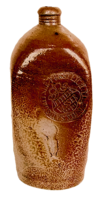Saidschitzer bitter water
The Saidschitzer bitter water ( Czech Zaječická hořká voda ) is a strongly mineralized medicinal water of the magnesium sulfate type (Epsom salt). It is used in traditional European balneology as well as in home drinking cures . The Saidschitz Epsom salt springs are located in Zaječice u Bečova (Saidschitz), a district of the municipality of Bečov (Hochpetsch) in the Czech Republic .
Discovery of Epsom salt springs
Epsom salt (magnesium sulfate) has been a very popular trade item since the Middle Ages. When the only known Epsom salt resources were mined in the English city of Epsom , the European nobility endeavored to find resources of a similar type. Therefore, their personal physicians began to look for a replacement.
In 1717 the personal physician of the Prussian ruler, Friedrich Hoffmann , found springs with bitter water near Sedlec and the village of Zaječice (Saidschitz) . In 1725 he published a report on the newly found sources which were supposed to be better than the original English sources. He sent this report to the European noble houses. Together with the chemists of the spa town of Teplice (Teplitz) he began to offer cleansing cures with the Seidlitzer and Saidschitzer bitter water, which increased the popularity of the Teplice spa system. Doctors also recommended drinking bitter water as an aid in the case of loss of appetite, obesity, stomach and gallbladder diseases, against arteriosclerosis, skin diseases and in neurology. Other important balneologists followed up on Hoffmann's work, including Josef von Löschner , AE Reuss and his son.
Manufacture of counterfeits and imitations
Almost immediately, the Seidlitzer and Saidschitzer Epsom salts were counterfeited, with a recipe for the so-called "Seidlitzer powder" being distributed worldwide from London. This preparation referred to the Saidschitz sources and was the most widely produced preparation of the newly emerging pharmacy. Due to the unsuitable composition of this imitation, this name was finally banned by the balneologists.
The development in the use of the springs was interrupted by the Silesian Wars of 1742–1763 . Around 1770, Matyáš Loos from Saidschitz opened the new mine. He began by shipping the water in clay jugs called “Genuine Saidschitzer bitter water from Matyáš Loos”. Loos soon became rich, and at the end of 1780 he had a chapel built in Saidschitz from the proceeds of the sale of the "Bitterwasser".
The ecclesiastical order of the Knights of the Cross from Seidlitz, who had the Seidlitz fountain not far, also opened shipping. Their jugs were labeled "Seidlitzer Bitterwasser". The income from the springs aroused the interest of the Lobkowicz Dominion from Bilin. In 1781 the wells were recorded, whereby the private wells of small farmers were abolished and only those with the strongest water were left in the administration of the rule. Everything that could harm the water was broken down and removed, especially the inflow of surface waters. The bitter water was then bottled in stoneware bottles labeled as “Genuine Lobkowicz-Saidschitzer Bitter Water”. The concern for the Saidschitz water later took over exclusively the Lobkowicz rule.
Since the Saidschitz water is never drunk for thirst, but only to achieve the required effect, it was used even then with an enrichment to the value of 34 grams of Epsom salt per liter. In the first half of the 19th century, the Saidschitzer area was already the main European supplier of bitter water for therapeutic purposes, with Saidschitzer bitter water gaining the reputation of the purest Epsom salt source in the world.
Currently, the Zaječická hořká voda (Saidschitzer bitter water) is mainly exported to China and other Asian countries as well as to Russia and the USA.
Web links
- Review of: Reuss, Franz Ambrosius: The Saidschitzer bitter water / described physically, chemically, and medically by Franz Ambros Reuss, the world wisdom and pharmacology doctor, the royal. bohem. Society of Sciences members. ; 1 tab. - Prague: Schönfeld u. Meissner, 1791
- Review of: The Saidschitzer bitter water / chemically investigated by Prof. Steinmann; histor., geognost. and shown healing. by Dr. Reuss. - Prague: Calve, 1827


